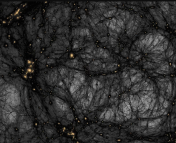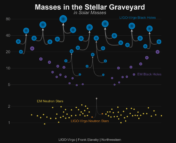Title: Probing the large scale structure using gravitational-wave observations of binary black holes
Authors: Aditya Vijaykumar, M. V. S. Saketh, Sumit Kumar, Parameswaran Ajith, and Tirthankar Roy Choudhury
First Author’s Institution: International Centre for Theoretical Sciences, Bangalore, India
Status: Open access on arXiv
Gravitational Wave Windows onto the Universe
When the Laser Interferometer Gravitational Wave Observatory (LIGO) turned on three years ago, it opened the window onto black hole collisions throughout the universe. These binary black holes (BBHs) emit gravitational waves (GWs) as they inspiral, and LIGO detects these spacetime ripples. Though observations of BBHs have begun streaming in, it turns out that the GW-windows are rather sparse and dirty (not unlike my New York City apartment).
The current LIGO run is part of the second generation of GW experiments; in the coming decades we will see the third generation (3G) come online, with the planned Einstein Telescope and Cosmic Explorer detectors. These are expected to detect tens of thousands of BBHs, an explosion of data compared to the relative pitch-blackness of the dozen or so LIGO BBH detections so far. However, this is still sparse compared to the millions of galaxies we have observed.
Further, we can only vaguely make out the location of BBH mergers. Through the eyes (or really, ears) of the detectors, we estimate smeared-out areas where the BBH might live. Current LIGO “localization regions” are between 30 and 2200 square degrees on the sky (for comparison, the largest constellation Hydra covers 1300 square degrees). 3G detectors will localize BBHs to within 1 square degree, but this is still a far cry from the pinpointed locations of galaxies.
Today’s authors take on the task of extracting information about BBHs through these less-than-ideal windows. They present a method to learn the relationship between BBHs, galaxies, and the underlying cosmic web—the large-scale structure of dark matter throughout the universe. This, in turn, provides insight into the origins of the black holes themselves.
A Smeared Signal of Black Hole Origins
What do binary black holes have to do with the cosmic web? Black holes, as with any gravitating matter, are expected to be tracers of the dark matter distribution. The question of how precisely BBHs trace the dark matter—how deeply entangled they are with the cosmic web—probes the origin of the merging black holes.
If the progenitors of BBH mergers are primordial black holes, which formed in the early universe, the gravitational wave signals would perfectly trace the dark matter. In this case BBHs would be unbiased tracers. If, on the other hand, they are astrophysical black holes that originated from stars, BBHs would tend to occur in more massive, star-packed galaxies. These galaxies are biased with respect to the cosmic web, meaning they are preferentially located at strong peaks in the dark matter density—so the BBHs would be biased too.
To explore these origin stories, the authors generate mock catalogs of the BBHs based on dark matter simulations. They distribute the BBHs depending on the “bias factor” bBBH: in some simulations, they assume that BBHs are unbiased (bBBH = 1) with respect to the dark matter, while in others they assume BBHs contain moderate to strong biases (bBBH = 1.2 and bBBH = 1.5). To account for the poor localization, they assign localization error regions to each true BBH, using a size based on the precision of 3G detectors; this probability field is shown in Figure 1. Then a different point is selected from the error region to represent the uncertain BBH observation.
The authors then compute the 2-point correlation function (2PCF) of the BBHs, which measures their clustering over a range of scales, from 10 to 50 Megaparsecs (Mpc). The uncertain localizations smear out the 2PCF compared to that of the dark matter or galaxies. Even so, the smeared 2PCF can distinguish between different values of the bias. Figure 2 shows the estimated 2PCF of BBH events from the simulation with bBBH = 1.5, compared to the expected 2PCF based on the input localization regions. The procedure is able to reasonably recover the true BBH 2PCF.
BBHs as Seen Through Shiny New Detectors
The authors use their simulations to make projections for how well future 3G detectors could measure the BBH bias factor. They perform these estimations assuming observation durations of 3, 5, and 10 years.
Given the sensitivity afforded by these durations, the authors try to recover the bias factor in their simulated observations; the results are shown in Figure 3. They find that at low redshift (a.k.a. in the nearby universe), the future detectors can measure the correct bias to within ~20% accuracy even with just a 5-year run. At high redshift, the larger localization errors make this task more difficult, but a 10-year run will still somewhat constrain the bias factor.
These projections show that next-generation GW detectors will be able to distinguish between bias factors, giving insight into whether BBH mergers came from primordial or astrophysical black holes. Further, this method uses only GW detections and doesn’t rely on electromagnetic observations. This means that source distances are only estimated from GWs, rather than from redshifts—that pesky stand-in for distances— allowing us to disentangle BBHs from other probes of the cosmic web. This provides a novel, redshift-independent probe of large-scale structure, in addition to a promising approach to probing BBH origins in the future.




